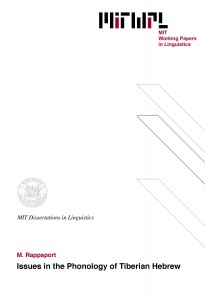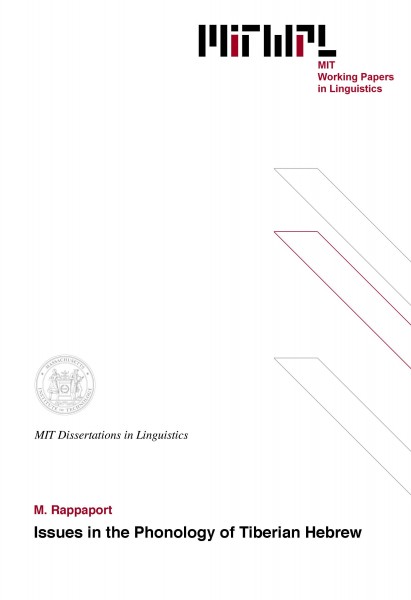Issues in the Phonology of Tiberian Hebrew
M. Rappaport, 1984
This thesis studies some central problems in the phonological analysis of Tiberian Hebrew (TH). Chapter 2 contains a detailed account of the accentual system of the language and an analysis of those aspects of the segmental phonology which interact with the accentual system. The account is set within a framework, the principles of which are formalized and justified in Chapter 1. I argue that the assignment of stress involves rules of tree construction and the interpretation of these trees in a metrical grid by rule. The theory of stress assignment adopted allows for a greatly simplified account of TH stress in which there is only one set of stress trees instead of the three postulated in previous metrical accounts. It is suggested that there are two different binary alternations in the language " stress and reduction " which are not perfectly aligned. The rules of vowel reduction and stress assignment are both taken to involve the construction of metrical trees with each set of trees interpreted by a different rule. The stress trees are interpreted by rules of grid construction and the reduction trees are interpreted by a segmental rule which only directly affects the process of grid construction. The ultra-short vowels of the traditional literature are identified as those vowels with no grid representation. These vowels are ignored by the rhythmic rules of the language which are formulated as operations on the grid. I argue that a theory using only a metrical grid with no recourse to metrical trees has difficulty dealing with certain stress shift phenomena which are at the heart of the TH accentual system and are dealt with naturally in the framework adopted here.
Chapter 3 presents a solution to a classical problem in the morphological analysis of the TH verbal system. It is shown that although triconsonantal roots may be associated with one of the three prosodic templates, at the deepest level of analysis there are only two such templates available to the morphology and that one of the templates is derived from another by rule. The solution makes crucial use of an autosegmental representation of morphemes and involves the postulation of two morphological strata in the TH lexicon.
Thesis supervisor: Morris Halle
Title: Institute Professor
Table of Contents
Chapter 1 Introduction 9
1.1 Metrical Phonology 9
1.1.1 The present theory 11
1.1.2 Previous metrical theories 43
1.2 Lexical phonology 68
1.3 Autosegmental phonology and morphology 73
Notes to Chapter 1 86
Chapter 2 The accentual structure of Tiberian Hebrew 87
2.1 Preliminaries 87
2.1.1 Three degrees of length in vowels 88
2.1.2 Main stress, vowel reduction and their interaction 94
2.1.3 Other ultra-short vowels 101
2.2 Previous metrical accounts 105
2.2.1 The interaction between MS and VR 105
2.2.2 Secondary stress 112
2.2.3 The rhythm rule 122
2.2.4 Hateph vowels 126
2.3 Analysis I: stress and stress related phenomena 130
2.3.1 Main stress 130
2.3.2 Vowel reduction 134
2.3.3 Secondary stress and grid construction 143
2.3.4 Main stress and secondary stress revisited 152
2.4 Two attempts at a grid-only analysis 164
2.4.1 The first attempt 164
2.4.2 The second attempt 171
2.5 Analysis II: Hateph vowels 178
2.5.1 Introduction 178
2.5.2 Vowel quality 186
2.5.3 The accentual properties of words with Hateph vowels 202
Notes to Chapter 2 210
Chapter 3 Triconsonantal stem shapes 212
3.1 The problem 213
3.2 An attempt at a segmental solution 217
3.3 Morphological strata 234
3.3.1 Spirantization 234
3.3.2 Echo 238
3.3.3 Pretonic lengthening and the word level 247
Notes to Chapter 3 253

